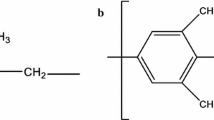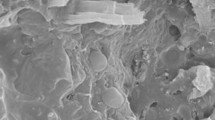Abstract
The physicochemical characteristics of production of ultrathin polypropylene fibres from polymer blend melts by use of specific fibre-formation are examined. The determining role of thermodynamic compatibility in fibre formation of one polymer in another is demonstrated and a method is proposed for improving it by adding special substances — compatibilizers — to the binary mixture. The copolymer of ethylene and vinyl acetate and sodium oleate are recommended as compatibilizers for PP/CPA blends. The types of specific reaction between the copolyamide macromolecules and the additives were established by IR spectroscopy. These include dipole-dipole and ion-dipole bonds that alter the rheological properties and improve the spinnability of the blend melts. Specific fibre formation for a PP/CPA ratio corresponding to the phase shift region appeared for the first time due to compatibilization. Complex fibres are obtained from polypropylene microfibres in spinning through one opening.
Similar content being viewed by others
REFERENCES
M. Yambrikh, D. Budzak, et al., in: Proceedings of the International Conference on Chemical Fibres “Khimvolokna 2000” [in Russian], Tver' (2000), p. 1.
E. M. Aizenshtein, O. N. Soboleva, and V. I. Isaeva, Khim. Volokna, No. 5, 3 (1997).
M. V. Tsebrenko, A. V. Yudin, et al., Polymer, 17, 831 (1976).
M. V. Tsebrenko, Int. J. Polym. Mater., 10, 83 (1983).
M. V. Tsebrenko, Ultrathin Synthetic Fibres [in Russian], Khimiya, Moscow (1991).
M. V. Tsebrenko, Khim. Volokna, No. 5, 32 (1980).
M. V. Tsebrenko, N. M. Rezanova, and I. A. Tsebrenko, Polym. Eng. Sci., 39,No. 12, 2395 (1999).
Yu. S. Lipatov, L. I. Bezruk, and E. V. Lebedev, Kolloidn. Zh., 27,No. 3, 481–486 (1975).
G. I. Taylor, Proc. Roy. Soc.-London, A146, 501 (1934).
L. A. Utracki and M. M. Dumoulin, Polypropylene: Structure, Blends and Composites, Chapman and Hall, London (1994), pp. 52–96.
M. V. Tsebrenko, N. M. Rezanova, et al., Polym. Eng. Sci., 39,No. 6, 1014–1021 (1999).
M. V. Tsebrenko, N. M. Rezanova, and I. A. Tsebrenko, in: Book of Int. Symp. on Polymer Composites Science and Technology, Quebec, Canada (1999), p. 453.
A. I. Rusanov and V. L. Kuz'min, Kolloidn. Zh., 49,No. 1, 59–60 (1987).
I. A. Tsebrenko and V. A. Pakharenko, Khim. Volokna, No. 3, 23–25 (1999).
M. V. Tsebrenko, N. M. Rezanova, and I. O. Tsebrenko, Khim. Promisl. Ukr., No. 1, 47 (1999).
Author information
Authors and Affiliations
Rights and permissions
About this article
Cite this article
Tsebrenko, M.V., Rezanova, N.M. & Tsebrenko, I.A. Ultrathin Polypropylene Fibres from Polymer Blend Melts. Fibre Chemistry 34, 263–270 (2002). https://doi.org/10.1023/A:1021045015324
Issue Date:
DOI: https://doi.org/10.1023/A:1021045015324




